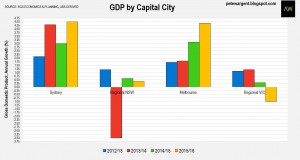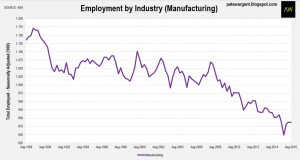Engines of prosperity
When looking through the figures for the 2014 financial year, I wrote here on Business Insider of my concerns for many parts of regional Australia, with slowing population growth, employment growth, and weak investment all becoming a major worry.
While it’s become popular to deride Sydney and Melbourne as parasite economies (obviously don’t export much in the way of coal, iron ore, and gas) this of course overlooks the services exports that the two largest cities do make in the form of tourism, education, and financial and other services.
For example, Sydney is by far and away by the most visited location by international tourists to Australia, an undisputed champion in this regard, while both of these capital cities have become a key destination for international students.
Moreover, the two cities combined are utterly dominating contributions to economic growth in Australia, with more than two-thirds of the contribution to GDP growth accounted for by only Sydney and Melbourne.
Capital cities lead
SGS Economics and Planning released its annual report into growth by capital city.
In the two most populous states, Sydney (with a blistering +4.5 per cent growth) and Melbourne (+4.4 per cent) dominated GDP growth in FY2015-16, a trend which has now become entrenched over the last four financial years.
In regional New South Wales the economy was flat at +0.1 per cent (negative in per capita terms, of course), while regional Victoria’s economy alarmingly contracted by fully -1 per cent.
In regional Victoria in the economy has slumped for the past four years, while average headline growth over 10 years has now slouched to just +0.5 per cent, also effectively a contraction in per capita terms.
Dire figures.
Regional Victoria in recession
Peter Martin, Australia’s best economics correspondent, writing for The Age, picks up the story to note that per capita GDP in regional Victoria has collapsed by 8 per cent since peaking in 2006-7, with manufacturing crashing by a horrific 26 per cent.
Martin cites the example of Morwell in the Latrobe Valley where multiple industry closures combined with the pending shuttering of Hazlewood has led the local economy to contract at a rate of around 2 per cent per annum.
While GDP per capita has risen to an all-time high in Sydney and Melbourne, GDP per person has declined over the past nine years in regional Victoria from an inflation adjusted $53,000 nine years ago to only $49,000 today.
Over the past 30 years Australia has shed more than 284,000 manufacturing jobs on a net basis.
Moreover, these jobs are not coming back.
Terry Rawnsley of SGS noted that he cannot see the trend toward regional malaise reversing, recommending that cities such as Geelong focus instead on building strong transport links to Melbourne.
Reported Martin:
“Dr Rawnsley’s calculations show regional Victoria deteriorating faster relative to Melbourne than it did when Jeff Kennett lost office.”
Regional NSW “recession hit” as Sydney booms
It’s a similar tale of a state divided in New South Wales, with Sydney’s economy accelerating to record a blazing +4.5 per cent growth compared to just +0.1 per cent for the rest of state.
Regional New South Wales has contracted at a rate of -0.3 per cent per annum over the last four years, while Sydney has averaged a growth rate of +3.4 per cent.
Sydney contributed 38.6 per cent of all of the national GDP growth in the financial year, the harbour city’s highest share since 1992, while Melbourne contributed another 28.4 per cent.
Matt Wade reports the Sydney side of the story for the Sydney Morning Herald:
“Rawnsley, an expert on regional economics who authored the paper, said the figures revealed a worrying pattern where a disproportionate share of economic activity and population was shifting towards the biggest cities.
This is an alarm bell ringing louder and louder. How will we manage this tidal shift of people into the city? Sydney’s population could grow by more than 2 million people over the next 20 years.”
Rates differential
These figures are worth remembering when people talk of parasite economies.
Strewth, without the contributions of Sydney and Melbourne there would be no Australian economic growth of which to speak.
Such is the difference between the respective conditions that if they were operating as standalone economies SGS estimates that Sydney would have a cash rate of 3.75 per cent and Melbourne 2.25 per cent.
On the other hand, given the recessionary conditions in the rest of state areas interest rates would need to be immediately cut to the effective zero lower bound for regional New South Wales and Victoria.
That’s how stark the difference in conditions is.
Unfortunately the Reserve Bank has only one lever or blunt tool, and as such left interest rates on hold today at 1.50 per cent, which is obviously a stimulatory setting for Melbourne, and hugely so for Sydney where the unemployment rate has sunk to well below 5 per cent.
On a related note, more GDP partials were reported today suggesting a possible negative print tomorrow.
Hold onto your hats!





No comments:
Post a Comment